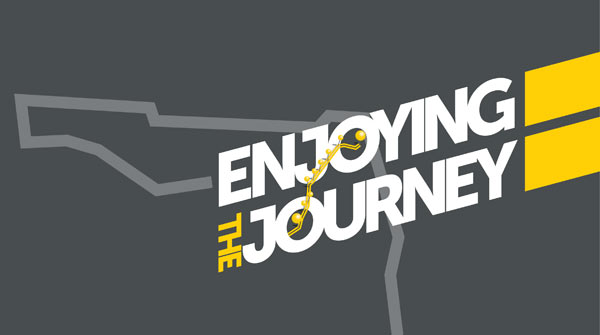
While we’re familiar with the line of strip malls, lodgings and restaurants surrounding Interstate 75 and the retirement communities lying beyond, the Cross Florida Greenway creates a buffer and gateway to authentic experiences stretching west to its end at US 41 in Hernando.
What fewer travelers know is that SR 200 stretches northeast of Ocala as well, through areas far less populated and decidedly nostalgic. Jump in the car and take a journey into Florida’s past. Turn north along US 301 at South Pine Street to follow SR 200 east—all the way to the Atlantic Ocean.
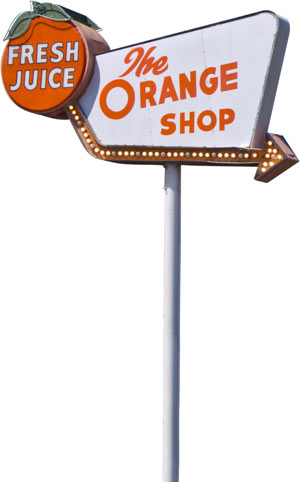 Oranges, Anyone?
Oranges, Anyone?
Give it up to Google. The first time I zoomed in on Google Earth and saw SR 200 listed along the route of US 301, it got me curious. A call to the Florida Department of Transportation confirmed the virtual map. When I walked into The Orange Shop in Citra and told shipping manager Karen Brinson I was researching the route, she was puzzled. “200? Here?” But Fletcher Kelly knew what I was talking about. At 85 years old, he’s been with The Orange Shop since 1951, and he still drives back and forth from Ocala to work every day.
“It’s changed greatly,” he says. “They were one-lane highways. When they four-laned, we had to dig up two rows of trees on each side of the road—orange trees—and move them to the back of the grove.”
The highway was expanded in the early 1960s.
“Where you see this shop,” adds Kelly, “down to the lake, there was nothing but flowers.”
“We have a lot of parents—and grandparents—bringing in the kids and saying ‘this is where we used to stop!’” says Brinson. The “clean restrooms” sign and free juice are the big draw, along with bags and bags of fresh-from-the-groves citrus. Honeybell, tangerines and classic Valencias are grown here.
“I planted most of them,” says Kelly, as he walked with me through the grove, the northernmost commercial grove in Florida. Owners Pete and Cindy Spyke also maintain groves near Weirsdale and Fort Pierce. Citrus is very much a seasonal industry, so The Orange Shop still closes down between mid-June and mid-October.
“You’re in business to take care of people,” says Kelly, who’s proud of their reputation for clean restrooms. “We make sure they’re clean,” he said. “That’s the priority here. That, and taking care of the shop. You have to know the fruit. If it’s not up front and we’ve got it, we go out back and bag it for you.”
Lochloosa Lunkers
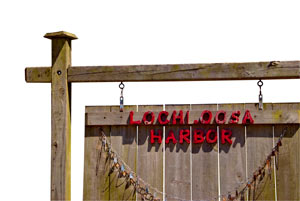 A quick pause at the CR 325 turnoff for Cross Creek shows off US 301 and SR 200 being one and the same—a road sign just south of the lakeside community of Lochloosa confirms.
A quick pause at the CR 325 turnoff for Cross Creek shows off US 301 and SR 200 being one and the same—a road sign just south of the lakeside community of Lochloosa confirms.
On any given weekday, you’ll find the streets clogged with pickup trucks and empty boat trailers dwarfing the postage-stamp of a post office next to Lochloosa Park, where a boat ramp beckons anxious anglers.
Lake Lochloosa, which connects with Orange Lake through Cross Creek, is a whopper.
“About 4 miles by 6 miles, 11 feet deep, and 4 to 5 feet deep along the rim,” says J.J. Pease, who runs Lochloosa Harbor Fish Camp. On the phone with a future spring breaker, he says, “you don’t want to swim in there, oh, no.”
That’s OK, though. They do rent canoes for paddling the shallows, and it’s only $2 to drop your boat in one of the “top ten speck lakes in the state.” Pease isn’t sure how old the fish camp is.
“It’s been here as long as the mist,” says Pease.Once owned by Wade Boggs, Lake Lochloosa is a cypress-rimmed destination for tournaments and landing your own lunkers.
“The biggest bass I weighed was 12 pounds, 2 ounces,” says Pease.
Where’s Waldo?
 Past the Waldo Motor Sports Park and its adjacent, often-busy campground, there’s no mistaking the giant rocking chair drawing your attention to the Waldo Farmer’s & Flea Market, open weekends since 1972. The daily attraction, however, is the Waldo Antique Village next door.
Past the Waldo Motor Sports Park and its adjacent, often-busy campground, there’s no mistaking the giant rocking chair drawing your attention to the Waldo Farmer’s & Flea Market, open weekends since 1972. The daily attraction, however, is the Waldo Antique Village next door.
“This building started as a tractor business,” says Manager Roseanna Smith, who’s been there almost as long as the store, which opened 18 years ago. “The windows came out of the Hawthorne School when they were tearing it down, and we found out not too long ago that the beams came from Cape Canaveral.”
Bargain hunters can browse for hours through nearly 80 dealer booths with everything from classic rock albums to Vaseline glass glowing under fluorescent lamps. With multiple staircases running up and down the two floors inside the 24,000-square-foot building, it’s a destination.
Yes, Smith knows that you have to run the gauntlet of ever-changing speed limit signs to get there.
“Did you know AAA made us famous?” he asks. “A lot of people don’t know that the cops who work here are trainees, because you just can’t come out of school and go straight to work in Jacksonville… this is a starting point for them to work their way up.”
Simply Starke
It’s not a name that rolls easily off the tongue, given its long-time association with the Florida State Prison and “Old Sparky,” which was retired in 2000. But Starke provided my first clue to “where does SR 200 go?” by appearing on a mileage sign in Citrus County.
Go straight where the highway curves for a different perspective on Starke. Founded in 1858 along the Florida Railroad—the tracks still slice through downtown—it’s the county seat of Bradford County. It’s also home to a rebirth of historical awareness along East Call Street, where showy early 1900s architecture sets the backdrop for car cruises and festivals, including the annual Strawberry Festival each April. Anchoring the west end of the historic district is the 1902 Bradford County Courthouse, a Romanesque Revival-style monument to government. At the east end, the Gene Matthews Bradford County Historical Museum is the repository of all things Starke, with a special emphasis on the economic forces that shaped the area—turpentine, logging and railroads.
Souvenir Land
Blink, and you’re in the 1960s. It’s a former Hornes turned roadside stand, recalling a misty past of orange-scented perfume balls, pecan logs and wind chimes made of strings of tiny sea shells. Blink again. It’s real.
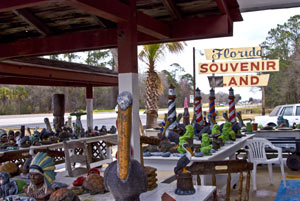
For more than 25 years, Florida Souvenir Land has been a landmark along this stretch of highway north of Lawtey, where a steady string of places like this tempted tourists coming down from the Georgia border, what with the “Rest Rooms Inside” sign, bags of fresh pecans and miniature license plates with your kids’ names on them.
The gal running the shop, who demurred to give her name, pulled out a photo of Florida Reptile Land and compared her memories with mine.
“It had a zoo in the back, and you’d walk around a great big circle and come out through the juice bar where you gave donations if you wanted to donate,” she says. When she recalled the piano playing chicken, I just had to laugh.
“They had a little square cage, right here by the side where you went into the zoo,” she recalled. “Drop a quarter in, and the chicken would peck out a tune on a miniature piano.
Train-spotting
It’s many a young boy’s dream to sit and watch the trains click-clack past as he’s eating lunch. In Baldwin, you have your choice of a Happy Meal or a BK Kids Meal to fulfill that fantasy. Right at the Interstate 10 interchange, the Baldwin Yard is a railfan’s delight.
An east-west road on a north-south journey, SR 200 follows the route of the original Florida Railroad, built in 1861, from Waldo northeast. Financed and run by Florida’s first senator, David Levy Yulee, the Florida Railroad drastically cut down shipping time to New Orleans by connecting two major Florida ports of the day. The Baldwin Yard marked the junction between the northeast-southwest Florida Railroad and the east-west Florida Atlantic and Gulf Central Railroad between Jacksonville and Lake City. Today, it remains a busy hub on the CSX system.
Railroad Crossroads
In Callahan, US 301 and SR 200 part ways. The original passenger depot now houses the West Nassau Historical Society, with a bright red caboose outside just waiting for a child’s photo. Callahan hosts a Railroad Days Festival every March.
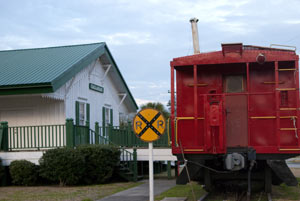
It’s here that SR 200 joins A1A—which, oddly, starts its southern coastal journey here by going northeast—passing beneath Interstate 95 just two exits south of the Georgia border.
David Yulee’s railroad was a significant target during the Civil War, especially near its terminus. The community of Yulee, east of I-95, pays homage to its namesake with interpretive information at a remnant of the original railroad bed inside John Muir Ecological Park, just west of US 17. Arriving in Florida in October 1867, Muir,considered the “father of the National Park System,” completed his “Thousand Mile Walk to the Gulf” by following the route of Yulee’s railroad all the way to Cedar Key.
The Isle of Eight Flags
Much as visitors off Interstate 75 see the not-so-authentic side of Ocala as they head into town, Fernandina Beach hides behind a swarm of strip malls as SR 200 guides you from Interstate 95 to downtown. Because of its deep-water port at the mouth of the St. Marys River, Fernandina Beach was always up for grabs by anyone who wanted to challenge the authority of Spain. During the American Revolution, it was a port of operations for the British against the colonists. In 1807, all American ports were closed to foreign shipping, but Fernandina was under Spanish rule. It slid into the ribaldry echoed throughout the Caribbean, where smugglers met, pirates plotted and racketeers reconnoitered.
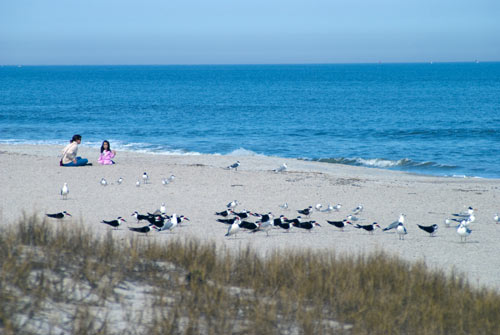
A big boom from the cannon at Fort Clinch dispels the thought of scoundrels surviving the unrest of the Civil War. Construction began in 1842 to protect the port. The battlements of Fort Clinch are as impressive today as when they were barracked. Designed as a third system fortress, it utilizes snazzy masonry tricks for roof support, including flying buttresses, circular staircases and hexagonal archways with bricks facing downward. But if you linger long during your tour, you might be pressed into laundry service by an officer, completely in character, living the present in the past.
End Of The Road
Richard Germano was one of those regulars from Waycross, Georgia, who followed SR 200 to the end of the road for a little relaxation.
“Best deep sea fishing on the coast!” he said. Germano bought a popular local restaurant, the Crab Trap, on a whim.
Now Fernandina has no lack of seafood restaurants. The shrimp can’t be any fresher. The Fernandina fleet has been going strong since 1900, and the Island of Eight Flags Shrimp Festival is nearly 50 years old. But the Crab Trap is different.
“People love the holes in the table,” says Max Wohlfarth, Richard’s son-in-law, manager and executive chef. “It saves a big mess for the waitress when you can drop all the shells and peelings into the hole. It makes dining with kids—or playful adults—a little tricky, too.
Savoring perfectly blackened shrimp with Max’s wife Holly, I discover the family’s love affair with Fernandina Beach keeps growing. Richard and his sisters bought the Amelia Motel in the late ’90s, later replacing the motor court with a 90-room hotel. It sits right on the circle overlooking the ocean, the surf competing for your attention against the 42-inch flat screen television and plush furnishings. No doubt the surf wins, though! Holly now manages the hotel, so her dad moved on to his next project, transforming a former Chevy dealership into a showcase of classic cars. Amelia Dream Cars won a historic preservation award this year, tempting passersby with beauties like a ’63 Thunderbird.
A block away is T-Rays Burger Station, open for breakfast and lunch. You’d mistake it for an actual Exxon if it weren’t for the picnic tables between the pumps. Grab your own drinks and utensils and settle down to a grilled-onion-smothered beauty of a burger, served up on mismatched plates in the ambiance of a gas station.
So where does SR 200 end?
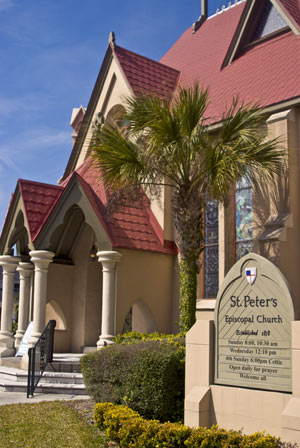 The last road sign you’ll see is at the corner of Centre Street, right in front of St. Peter’s Episcopal Church, founded in 1858. To the left is downtown Fernandina Beach, a colorful historic district bustling with shops, galleries, restaurants and one of the last bastions for bibliophiles, two independent bookstores. The elder statesman, the Book Loft, has a decidedly collectible bent. The younger, Books Plus, shows a playful side for kids, including an indoor gazebo for snuggling up for story time. Centre Street ends at the marina.
The last road sign you’ll see is at the corner of Centre Street, right in front of St. Peter’s Episcopal Church, founded in 1858. To the left is downtown Fernandina Beach, a colorful historic district bustling with shops, galleries, restaurants and one of the last bastions for bibliophiles, two independent bookstores. The elder statesman, the Book Loft, has a decidedly collectible bent. The younger, Books Plus, shows a playful side for kids, including an indoor gazebo for snuggling up for story time. Centre Street ends at the marina.
Google provides an alternate ending. It shows SR 200 gliding past Victorian homes in the historic residential district, passing over the salt marsh of Egan’s Creek and by the entrance to expansive Fort Clinch State Park, and ending at the Atlantic Ocean at Main Beach. Either ending is a happy one for a weekend away. Can you say road trip?
If You Go
The Orange Shop floridaorangeshop.com
Lochloosa Harbor Fish Camp lochloosaharbor.com
Waldo’s Farmers and Flea Market waldofarmersandfleamarket.com
Hampton Lake Bed & Breakfast hamptonlakebb.com
Gene Matthews Bradford County Historical Museum (904) 964-4606
Railroad Days Festival wnhsfl.org
Fort Clinch State Park floridastateparks.org/fortclinch
The Crab Trap crabtrapamelia.com
Island of Eight Flags Shrimp Festival shrimpfestival.com
Amelia Hotel at the Beach ameliahotel.com
Amelia Dream Cars (904) 310-6792
T-Rays Burger Station (904) 261-6310
The Book Loft (904) 261-8991
Books Plus booksplusamelia.com






